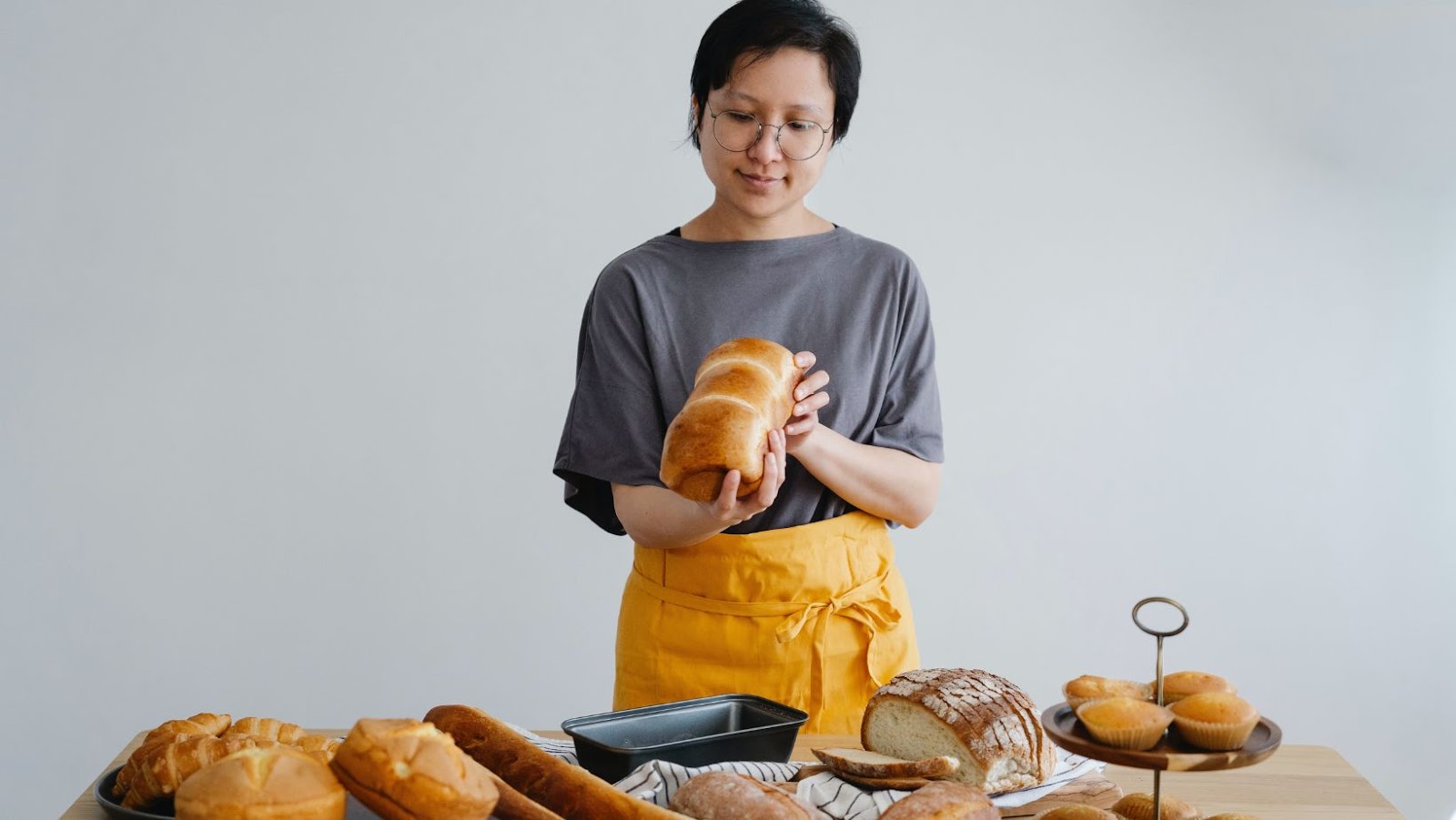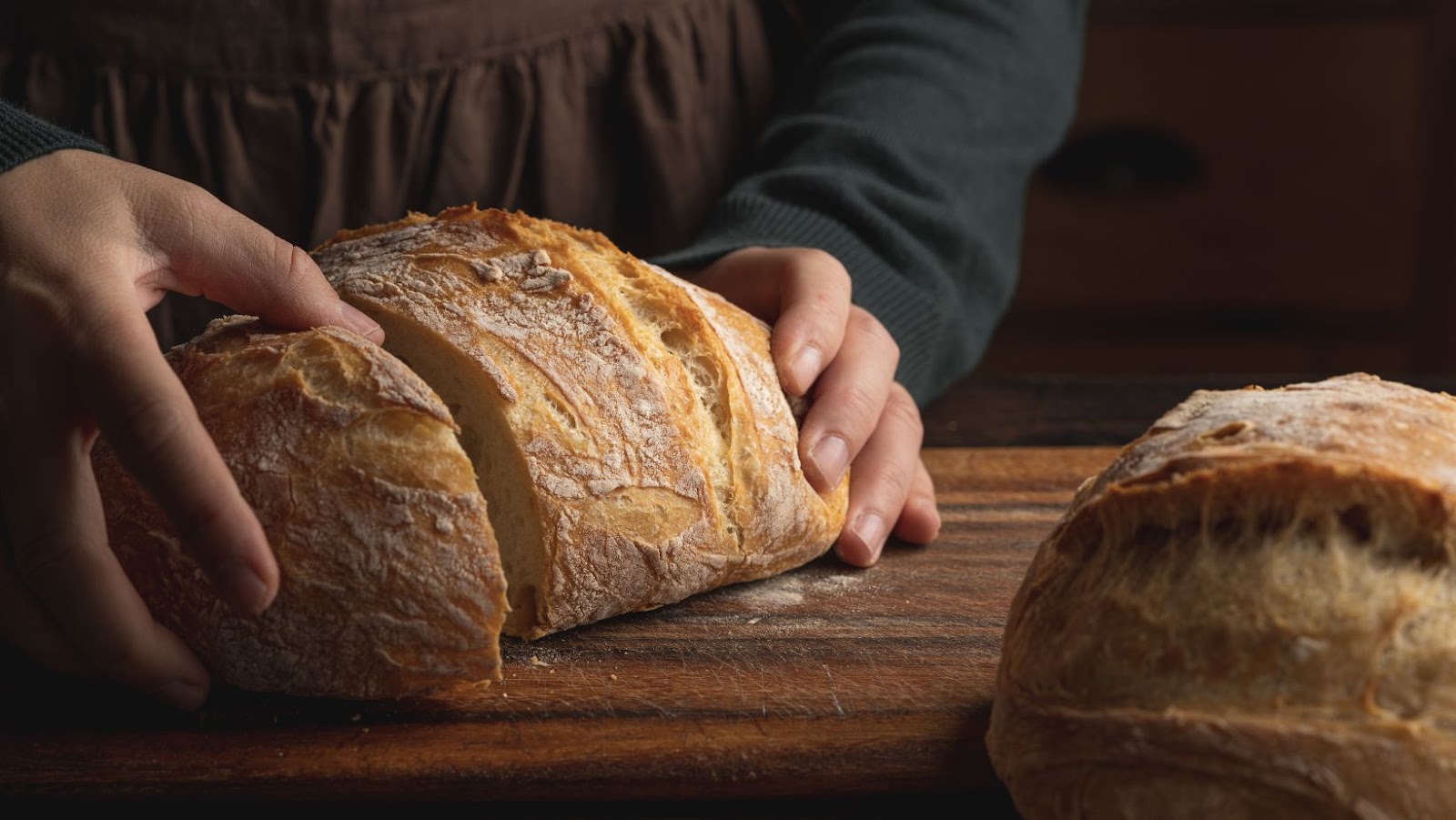Take Your Home Baking Business to The Next Level

Starting a home baking business can be an exciting and profitable venture. Here are some tips on how to take your home baking business to the next level and turn your passion into a successful and thriving business.
1. Check the legal requirements: Before starting your business, research the local and state regulations, permits, and licenses required to sell food from home.
2. Develop a business plan: Create a strategy that outlines your business goals, target customers, products, pricing, marketing tactics, and financial projections.
3. Choose your niche: Determine your signature product(s) and focus on perfecting them. Specialize in a specific type of baked goods, such as gluten-free or organic, to stand out from the competition.
4. Invest in quality ingredients and equipment: Use high-quality ingredients to make delicious and visually appealing baked goods. Invest in essential equipment such as ovens, mixers, and baking tools to enhance your productivity and efficiency.
5. Build a strong online presence: Create a social media page and website to showcase your products, story, and brand. Use professional photos, engaging captions, and customer testimonials to build trust and connection with your audience.
With these tips, you can start a thriving home baking business and turn your passion into a lucrative career.
How to Start a Home Baking Business
Starting a home baking business involves many legal and administrative considerations. Depending on the size and scope of your business, you may need to obtain permits and licenses, pay taxes, and set up a compliance plan. Knowing the laws in your area is essential to running a successful business.
Let’s explore these legal and administrative considerations.
Register Your Business and Obtain Necessary Permits and Licenses
If you are looking to start a home baking business, it is important to register your business and obtain the necessary permits and licenses to operate legally.
Here are the steps to follow:
- Choose a unique name for your business and register it with your state or local government.
- Obtain a tax identification number from the IRS and register for sales tax with your state’s revenue agency.
- Apply for a home occupation permit from your city or county zoning office to operate a business from your home.
- Check with your state’s department of health to determine if you need a food service permit or any special licenses to sell baked goods.
Pro Tip: It is advisable to check your state and local laws and regulations before starting any business from your home. It is better to be safe than sorry.
Determine and Comply with Local Health and Safety Regulations
When starting a home baking business, determining and complying with local health and safety regulations is critical for your success.
Here are some legal and administrative considerations to take into account:
Research the laws and regulations in your area regarding food handling and preparation, zoning, and permits.
Obtain the necessary licenses and permits to operate a home baking business in your area.
Ensure that your kitchen meets all health and safety standards, including temperature control, sanitation, and hygiene.
Label your baked goods with all the required information, including the list of ingredients and any allergens.
Keep accurate records of your income, expenses, and taxes to comply with your local tax laws.
By following these legal and administrative considerations, you can start and run a successful home baking business that complies with all health and safety regulations.
Obtain Liability Insurance
When starting a home baking business, it’s vital to obtain liability insurance to protect yourself and your business from potential legal and financial issues.
Liability insurance covers damages or injuries that may occur as a result of consuming your baked goods, such as food poisoning or allergic reactions. Without insurance, you may be personally liable for any damages or legal claims made against your business.
Here’s how to obtain liability insurance for your home baking business:
1. Research and compare insurance companies and policies.
2. Determine the type and amount of coverage you need.
3. Request quotes and review the terms and conditions of each policy.
4. Select the policy that best meets your needs and budget.
With liability insurance in place, you’ll have peace of mind knowing that you’re protected in case of any unforeseen events.
Setting Up Your Home Baking Business
Starting a home baking business can be an exciting venture. Not only can you make money from your delicious creations, but you can also enjoy the satisfaction of seeing your creations enjoyed by others.

However, the key to having a successful home baking business is knowing how to set it up properly. Let’s discuss the steps you should take to get started with your home baking enterprise.
Creating a Business Plan
Creating a business plan is an essential step to take your home baking business to the next level. Here are the key elements that you should include in your business plan:
Executive Summary: This section should provide an overview of your business, including your mission statement, products, target market, and financial projections.
Market Analysis: This section should cover the analysis of your target market, industry trends, and competition.
Products and Services: This section should describe your baked goods, including their unique features, pricing, and delivery options.
Marketing and Sales Strategies: This section should outline your approach to promoting and selling your baked goods, including pricing strategies, marketing channels, and customer outreach.
Management and Operations: This section should describe your management structure, staffing plans, and operational processes.
Financial Projections: This section should include projected financial statements, such as income statements, balance sheets, and cash flow statements.
Pro Tip: Once you have created a business plan, regularly review and update it to reflect changes in your business and industry trends.
Equipping Your Kitchen and Workspace
Having the right equipment is crucial to set up a successful home baking business. Here is a list of the essential equipment you need:
1) Oven: A standard-sized oven is an essential piece of equipment for baking cakes, cookies, and other goodies.
2) Mixer: Invest in a stand mixer and hand mixer to make the mixing process easier, faster, and more efficient.
3) Measuring tools: A set of measuring cups and spoons is necessary to ensure accurate measurements for baking.
4) Baking pans: Stock up on baking pans of various shapes and sizes, including cake pans, muffin tins, and cookie sheets.
5) Cooling racks: These come in handy when cooling baked goods, as it allows air to circulate around them, preventing sogginess.
6) Baking utensils: Wooden spoons, spatulas, and whisks are necessary for mixing and blending ingredients.
7) Ingredients: Stock up on all the basic baking ingredients such as flour, sugar, baking powder, baking soda, vanilla extract, salt, yeast, and eggs.
Pro Tip: Invest in quality equipment and ingredients to elevate the taste and presentation of your baked goods, and in turn, boost your business.
Sourcing Ingredients and Supplies
Sourcing high-quality ingredients and supplies is essential for starting a successful home baking business. Here’s how you can ensure you have top-notch ingredients and materials.
Research suppliers: Start by researching suppliers online and in your local area. Look for those who specialize in baking supplies and ingredients, and read reviews from other home bakers to get a sense of quality and pricing.
Buy in bulk: Once you’ve found suppliers you like, consider buying in bulk to save money. This is especially important for ingredients you use frequently, such as flour or sugar.
Choose high-quality ingredients: When it comes to baking, the ingredients you use matter. Choose high-quality ingredients for the best taste and texture in your baked goods.
Invest in quality equipment: Invest in high-quality equipment that will stand the test of time. This includes mixers, baking pans, decorating tools, and more.
By sourcing the best ingredients and supplies, you can take your home baking business to the next level and produce high-quality baked goods that keep customers coming back for more.
Marketing and Branding Your Home Baking Business
To help your home baking business reach a larger audience, effective marketing and branding strategies should be implemented. Whether it be through social media, print advertisements, or even word of mouth, getting your name out there is the key to success in any business.
Let’s look at some tips and tricks to help market and brand your home baking business.
Defining Your Target Market
Defining your target market is a crucial step in marketing and branding your home baking business. Understanding who your ideal customers are is essential to tailoring your products and services to meet their needs and preferences. Here are some tips to help you define your target market:
1. Conduct market research to gather information about your potential customers, such as their age, gender, income, interests, and buying habits.
2. Analyze your competition to see who they are targeting and how you can differentiate yourself.
3. Develop buyer personas or fictional representations of your ideal customers based on your research and analysis.
4. Use your buyer personas to craft targeted marketing messages and promotions that will resonate with your target audience.
By defining your target market, you can create a more effective marketing strategy that will help grow your home baking business and attract loyal customers who love your products.
Creating a Memorable Brand Identity and Logo
Creating a memorable brand identity and logo is essential for marketing and branding your home baking business and taking it to the next level. Your brand identity and logo will convey your unique selling proposition, create a lasting impression on customers, and differentiate you from the competition.
Here’s how to create a memorable brand identity and logo for your home baking business:
1. Define your unique selling proposition.
2. Develop a consistent color scheme, typography, and visual elements that reflect your brand personality and values.
3. Choose a memorable and distinctive logo that incorporates your brand elements and appeals to your target audience.
4. Use your logo and brand identity consistently across all marketing channels, including social media, website, packaging, and advertising.
With a memorable brand identity and logo, you can attract more customers, increase brand recognition, and take your home baking business to the next level.
Developing a Marketing Plan and Strategy
Developing a marketing plan and strategy is crucial to take your home baking business to the next level, by identifying your target audience, building brand awareness, and boosting sales.
Here are the key steps to follow:
Identify your target audience: Analyze the demographics, psychographics, and behaviors of your customers to create a customer persona that represents your ideal buyer.
Build a brand identity: Develop a unique and memorable brand name, logo, tagline, and visual identity that resonates with your target audience and differentiates you from competitors.
Build a strong online presence: Create a website, social media profiles, and online listings that showcase your products, mission, and values, and engage with customers through comments, reviews, and posts.
Offer promotions and rewards: Create incentives such as discounts, referral programs, and loyalty programs to encourage repeat purchases and increase customer satisfaction.
Track and evaluate your marketing efforts: Use analytics tools to monitor your website and social media performance, track your sales and conversions, and adjust your marketing strategy accordingly.
Pro tip: Don’t be afraid to experiment with new marketing tactics, such as influencer partnerships, content marketing, or events, to attract new customers and increase brand awareness.
Pricing and Selling Your Products
You’ve done your research and you know the basics of starting a home baking business. Now it’s time to decide what your products are going to cost. To make sure you are profitable, it is important to have the right pricing and sales strategies.
In this section, we’ll explore the key pricing and selling strategies for a successful home baking business.
Calculating Baking Costs and Profit Margins
Calculating your baking costs and profit margins is essential for pricing and selling your products and taking your home baking business to the next level.
Here’s how to do it effectively:
Calculate your ingredient costs per recipe and per unit.
Include indirect costs such as utilities, packaging, and labor.
Set a profit margin goal – typically between 20-50% of the total cost.
Determine the selling price per unit by adding together the ingredient costs, indirect costs, and desired profit margin.
Compare your prices to competitors and adjust accordingly.
Track your sales and costs to reassess your prices regularly.
Pro tip: Don’t forget to calculate your time and labor costs accurately. Don’t undervalue your time and effort. Remember, pricing your products effectively will help your business grow and be successful in the long term.
Determining Competitive Pricing
Determining competitive pricing is a crucial step in pricing and selling your products as you start your home baking business. You need to find the sweet spot between pricing too high to lose customers and too low to undervalue your skills and time.

Here are some factors to consider when determining your pricing:
- Ingredient costs: Calculate the cost of ingredients and materials used in your baking.
- Overhead costs: Include expenses such as rent, equipment, utilities, and permits.
- Labor costs: Determine the amount of time you spend on each baked good and assign an hourly rate to it.
- Market analysis: Research your competitors’ pricing and adjust yours accordingly.
- Profit margin: Decide on your desired profit margin and adjust your pricing to reach it.
Remember, pricing is not set in stone, so it is okay to make adjustments as you get a feel for your market and business. Pro Tip: Offering discounts on bulk orders or for repeat customers is an excellent way to build a loyal customer base.
Choosing Your Sales Channels (Online, In-Person, etc.)
Choosing the right sales channels is crucial when starting a home baking business. There are a few options to consider to maximize your reach and profits.
Online: Having an online presence, such as a website or social media page, can give you access to a wider audience. Consider offering online ordering and shipping options to reach customers who may not be in your immediate area.
In-person: Selling your baked goods in person can be a great way to build relationships with customers and earn their loyalty. Consider setting up a booth at a local farmer’s market or flea market, or partnering with a local coffee shop to sell your products.
Wholesale: Selling your products at wholesale prices to local stores, restaurants, or cafes can be a reliable source of income for your business.
It’s essential to understand the potential costs and profits associated with each sales channel before making a decision. Consider factors such as transportation costs, storage fees, and time commitment when weighing your options.
Pro Tip: Consider creating a business plan before launching your home baking business. This will help you identify your target market, your unique selling point, and your pricing strategy, among other important factors.
Scaling Your Home Baking Business
Starting a home baking business is relatively easy and low-investment, but scaling your business to the next level can be a little more challenging. It’s important to have a detailed business plan and be organized with the business side of the baking process.
Scaling your home baking business can take time and require a lot of energy, but with the right resources and a bit of dedication, it can be done.
Let’s dive into the details of taking your home baking business to the next level.
Expanding Your Product Line
Expanding your product line is a key strategy for scaling your home baking business and taking it to the next level.
Here are some tips to help you expand your product line:
1. Research your target market to identify the products in high demand.
2. Experiment with new recipes and flavors to keep your offerings fresh and appealing.
3. Collaborate with other local food vendors to create new and unique products.
4. Consider offering seasonal items or limited-time products to create a sense of urgency and excitement among your customers.
5. Showcase your products creatively using social media platforms to attract new customers.
Remember to test your products thoroughly before introducing them to the market and always prioritize quality and consistency.
Pro Tip: Building a strong brand and loyal customer base can set you apart from the competition and help you achieve sustainable growth in your home baking business.
Hiring and Managing Employees
Hiring and managing employees is an essential aspect of scaling your home baking business and taking it to the next level. Here are a few steps you can follow to find and onboard the right employees.
Write a clear and detailed job description that outlines the ideal candidate, skills required, and job responsibilities.
Post the job listing on reliable job boards and spread the word within your network or baking community.
Conduct interviews and try to get to know the candidate’s values, work ethic, and baking skills.
Run a background check on the final candidate to ensure they have a clean record.
Train the new employee on the business’s baking techniques, customer service standards, and company policies.
Provide regular feedback and offer opportunities for growth and development.
By hiring and managing the right employees, you can increase your production capacity, improve your customer service, and take on bigger orders, ultimately growing your home baking business.
Finding Wholesale Opportunities and Establishing Partnerships
Establishing partnerships and finding wholesale opportunities are vital steps to scale your home bakery business and take it to the next level. Here’s how you can do it:
1. Identify potential wholesale clients: Start by listing potential clients where you can provide your baked goods on a regular basis. These can be local cafes, restaurants or grocery stores.
2. Network: Attend local networking events and spread the word about your business. Make connections with people in the industry and offer samples.
3. Be Proactive: Reach out to potential clients and offer them your products. Explain what makes your business unique and why your baked goods are better than your competitors.
4. Build partnerships: Collaborate with businesses that complement yours, such as a coffee shop or a catering service. Offer them a percentage of your sales for referring your products.
5. Offer competitive pricing: Make sure your pricing is competitive and attractive to your clients. Don’t forget to include your costs and profit margins.
Finding wholesale opportunities and establishing partnerships can help you reach more customers and grow your business exponentially. Pro Tip: Always maintain the quality of your products and provide excellent customer service to build lasting partnerships.

 The Benefits Of Outdoor Sofa Deep Seating
The Benefits Of Outdoor Sofa Deep Seating  This Method has Been Used for Centuries
This Method has Been Used for Centuries  The Different Types of Bonds
The Different Types of Bonds  Solar Panel Cost And Efficiency
Solar Panel Cost And Efficiency  The Most Comfortable Deep Seating Outdoor Furniture
The Most Comfortable Deep Seating Outdoor Furniture  Maintaining Your Glass Cabinet Doors
Maintaining Your Glass Cabinet Doors